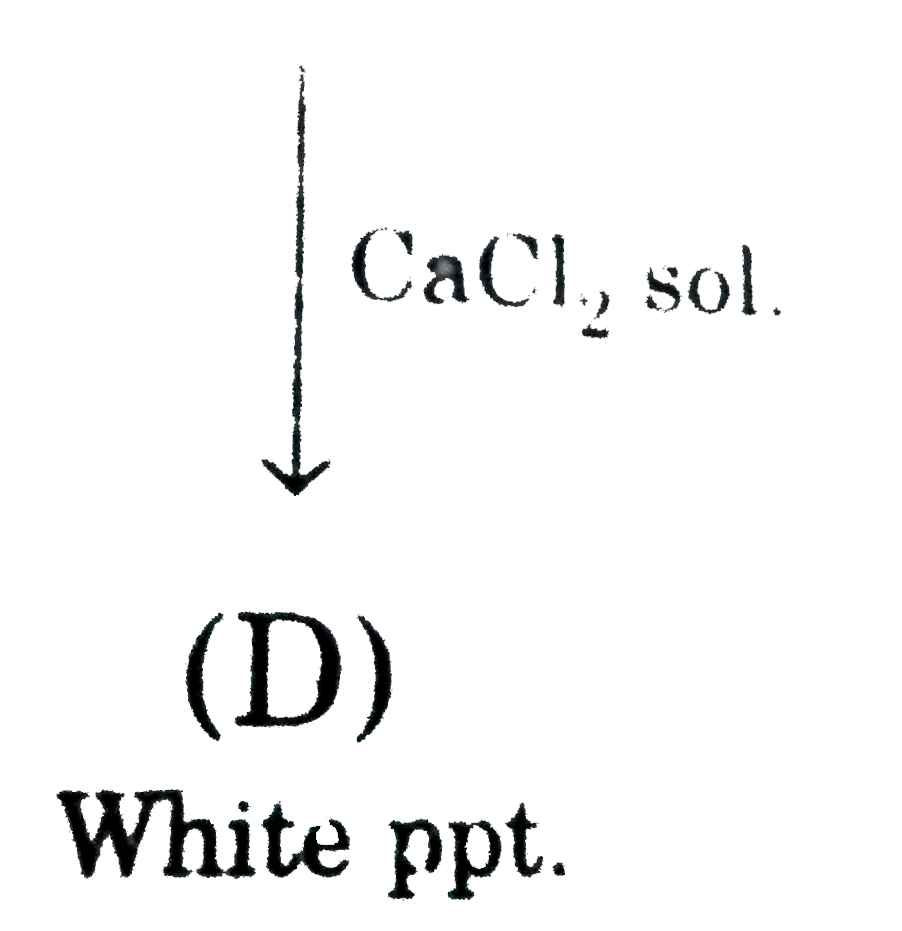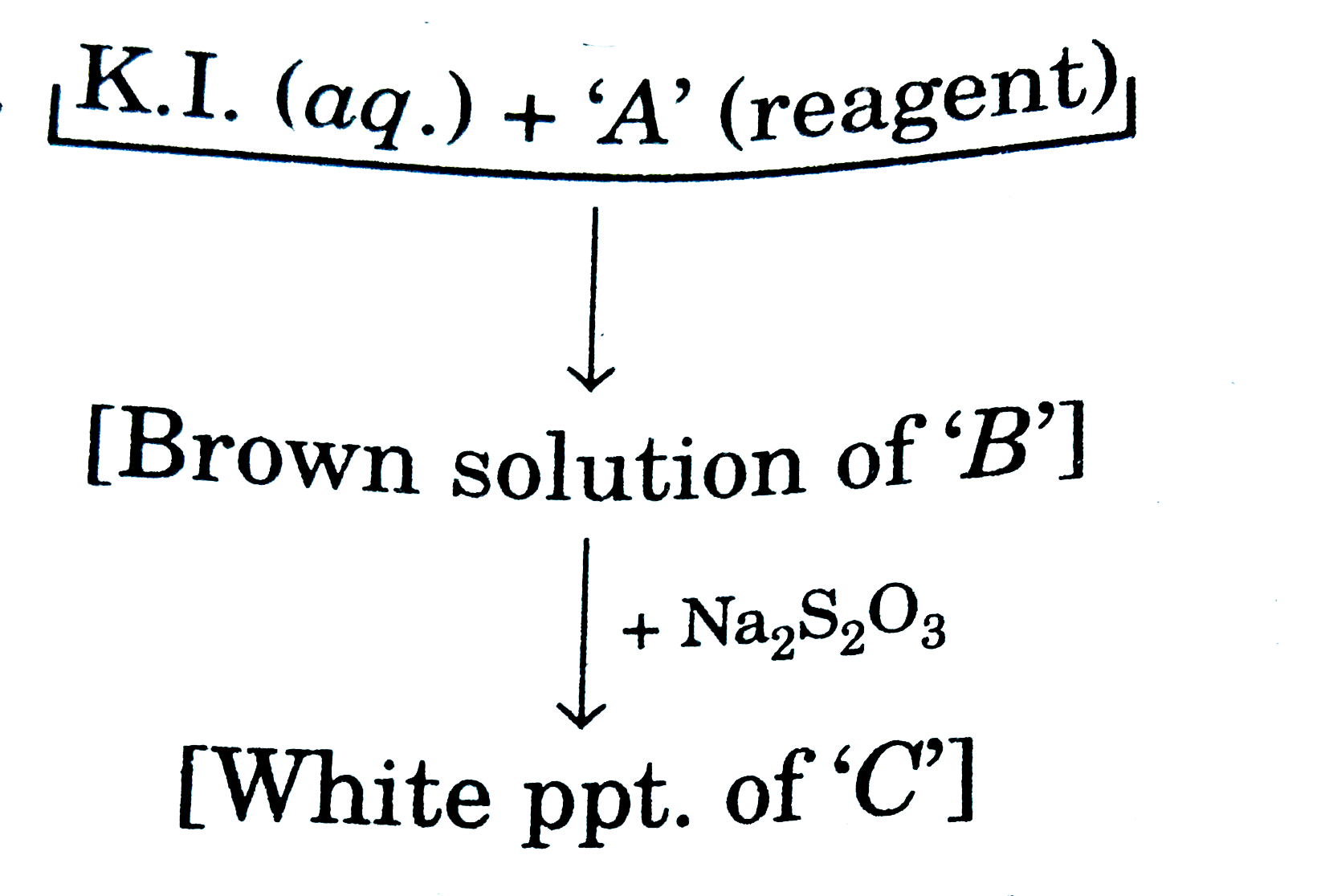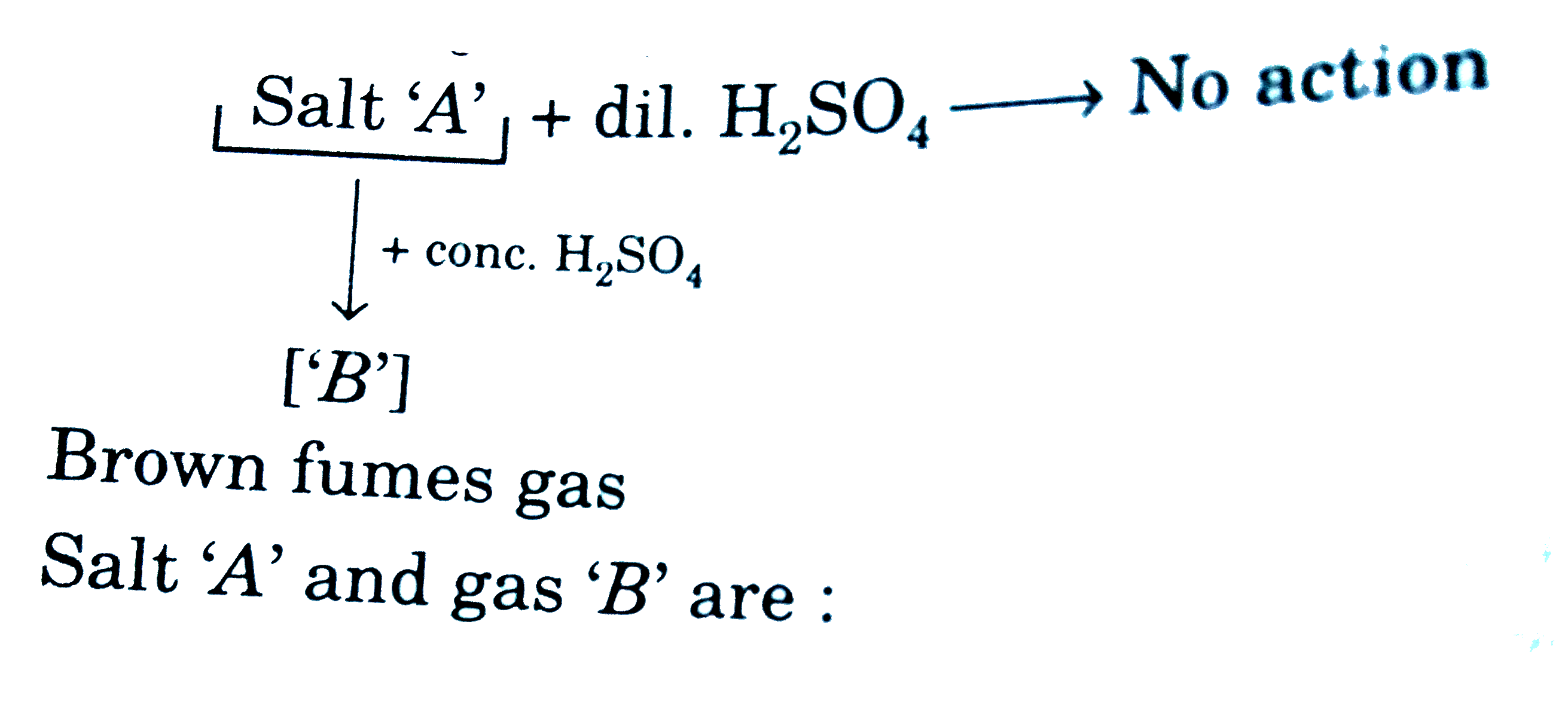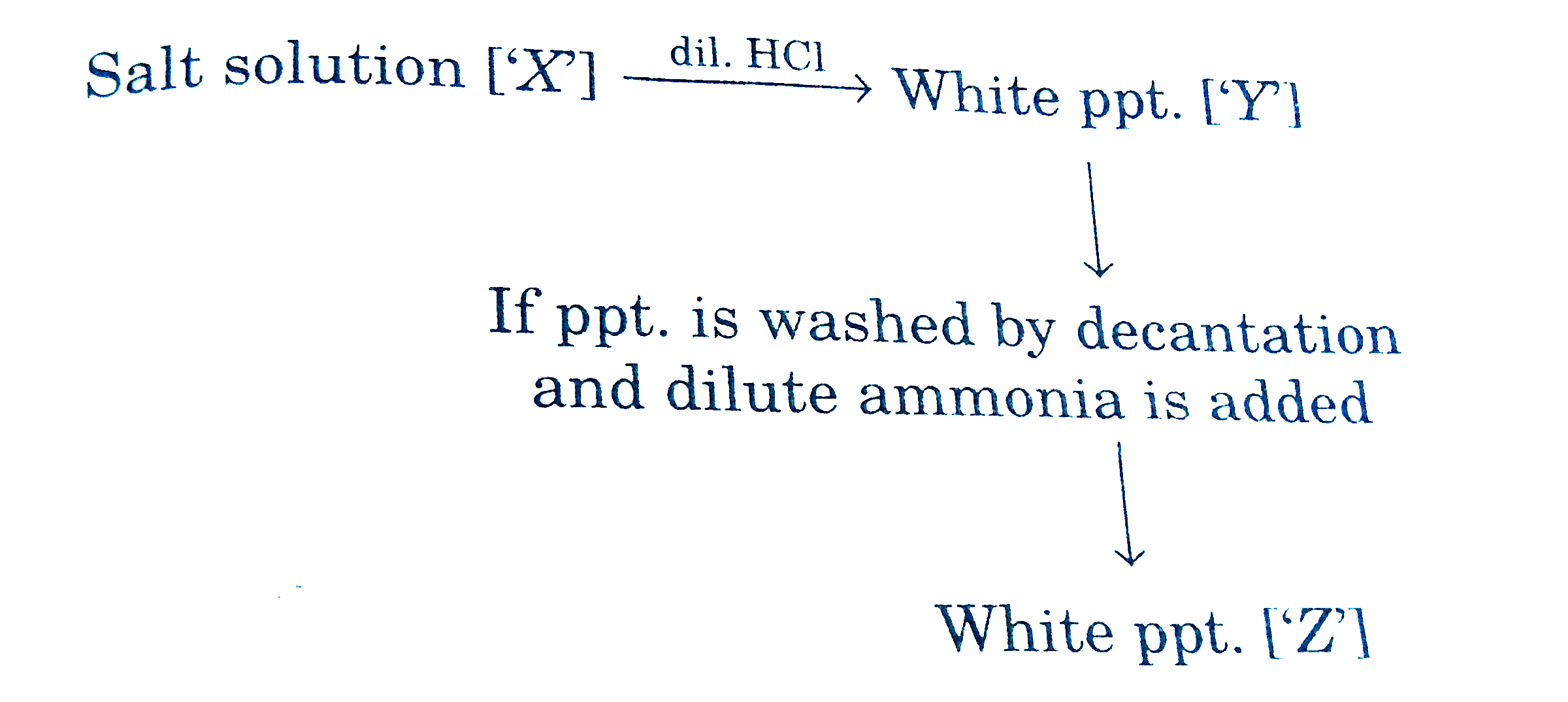Complete Solutions to L: Miscellaneous of chapter SALT ANALYSIS of Class 11 book with complete answers and questions
| Class 11 | CHEMISTRY |
| Chapter | SALT ANALYSIS |
| GRB PUBLICATION | L: Miscellaneous |
| Number Of Questions | 40 |
| Academic Year | 2023-24 |
Which of the following compound(s) slowly disappears on prologed passage of `CO_(2)` in aqueous solution:
View Solution(I) Salt of `'X' +CaCl_(2)` (excess) `rarr 'Y'+` Filtrate (II) Filtrate `+` Boiling `rarr 'Y'`
Here, salt 'X' is:
View Solution

In the abive scheme, suggest the most probable of A.
View SolutionWhat colour of ppt is formed when `KHCO_(3)` reacts with excess `AgNO_(3)`, followed by boiling?
View SolutionWhich of the following does not form volatile product with conc. `H_(2)SO_(4)`?
View SolutionWhich of the following bicarbonate does not exist in solid state?
View Solution(I) Salt 'A' + dil `H_(2)SO_(4) rarr 'B'` gas ['B' has suffocating odour]
(II) Salt `'A' +Pb(OAc)_(2) rarr C (darr) overset(Delta)rarr'D' (darr)` ['C' and 'D' both are white ppt.]
Here, anion of salt 'A' and 'D' are:
View SolutionAqueous solution of a gas 'X' decolourises an acidified `K_(2)Cr_(2)O_(7)` solution and on passing `H_(2)S` in the solution gives white turbity 'Y'. Here 'X' and 'Y' respectively are:
View Solution`Na_(2)S_(2)O_(3) overset(dil. H_(2)SO_(4))rarr Na_(2)SO_(4) +S (darr)+'B'` (gas) `'B' +Ba(OH)_(2) rarr {:(underset(("white ppt"))('C'(darr)+H_(2)O)),(" "darr'B'),("Clear solution" 'D'):}`
Here 'B' and 'D' are:
View SolutionThe sulphide ion gives purple colour which sodium nitroprusside. The purple colour is due to the formation of:
View SolutionWhich of the following statement is correct, about ''on passing `H_(2)S` gas through acidified `K_(2)Cr_(2)O_(7)` solution''?
View Solution`{:('X'+CuSO_(4)rarrubrace(I_(2))+"White ppt"[Y]),(" "darrNa_(2)S_(2)O_(3)):}`
`NaI +[Z]` colourless compound. Here, compound [Z] is:
View Solution`{:(FeCl_(3)+'X'("salt solution")rarr,'Y'("dark violet colouration")),(," "darr"on standing"),(,["Colour disappears"]):}`
Here 'X' and 'Y' are:
View SolutionWhich of the following compound is insoluble in water?
View SolutionWhich no mixing gives deep brown colour :
View SolutionSodium nitroprusside produces violet colouration when reacted with `Na_(2)S` due to:
View SolutionWhich of the following group reagent is preferred to give vinegar-like odour on warming?
View SolutionAnion that cannot decolourise acidic solution of `KMnO_(4)`:
View SolutionAq. Solution of `'A' overset(Na_(2)S_(2)O_(3))underset("solution")rarr` White ppt/turbidity solution which is not 'A' from the following:
View SolutionWhich of the following reagent is used with `KI` solution to give pure `HI`?
View SolutionWhen 'A' salt solution is added carefully to a saturated solution of `Fe(II)` sulphate acidified with dilute `H_(2)SO_(4)` a brown ring is formed at the junction of two liquids. Salt 'A' may be:
View SolutionAn inorganic salt solution 'M' gives white precipitate with `Pb(OAc)_(2)` solution. The ppt. dissolves on warming but forms needle like crystals on cooling. The salt 'M' contains:
View SolutionThe mixture of salts `NaCI,NaBr, NaI` on adding conc. `H_(2)SO_(4)` and followed by warming gives gases respectively:
View Solution
Compound 'A' and 'C' may be:
View SolutionAq. Solution of `'A' overset(Na_(2)S_(2)O_(3))underset("solution")rarr` violet ppt. Which may be 'A' from the following?
View Solution
Brown fumes gas
Salt 'A' and gas 'B' are:
View Solution
Brown fumes of 'X' + Blue coloured solution of 'Y' Here 'Y' is:
View SolutionConcentrated solution of which salt gives white precipitate with ferric chloride solution:
View SolutionChoose the correct statements from the following:
View SolutionWhich of the following compound is not soluble in conc. `(50%) HNO_(3)`?
View SolutionSilver is not produced when:
View SolutionWhich of the following compound gives a black precipitate with ammonia solution?
View SolutionWhich of the following cations give black precipitate with `H_(2)S` gas as well as soluble with excess yellow sodium disulphide?
View Solution
Here, white ppt. of ['Y'] is:
View SolutionAddition of `SnCI_(2)` to `HgCI_(2)` gives a ppt. which is:
View SolutionA metal ion 'X' reacts with `NaOH` to give a white ppt. precipitate can be oxidised by 4-6 drops of conc. `H_(2)O_(2)`, when yellowish brown coloured solution is formed. The metal ion 'X' is:
View SolutionWhich of the following metal sulphide is soluble in hot and conc. `HNO_(3)` as well as aq. KCN?
View SolutionWhich of the following metal cation gives yellow ppt. with pyrogallol (10% freshly prepared)?
View SolutionWith 'X' cation `[Fe(CN)_(6)]^(4-)` gives prussian blue colouration due to the formaion of ferri-ferro cyanide, `Fe_(4)[Fe(CN)_(6)]_(3)` while with `NH_(4)SCN, 'X'` cation gives....
View SolutionTurnbull's blue is formed when `Fe^(+2)` ions are added to `K_(3)[Fe(CN)_(6)]`. Turnbull's blue is:
View Solution
L: Miscellaneous questions and complete solutions for chapter SALT ANALYSIS of GRB CHEMISTRY (HINGLISH) of Class 11
All Exercises from GRB PUBLICATION Class 11 CHEMISTRY SALT ANALYSIS
- A. Experimental (Laboratory/Apparatus Based)
- B. Dry Tests/Colour/Solubility/Heating Effects
- C.Class- A Subgroup-I-Acidic Radicals
- Comprehension
- Comprehension 1
- Comprehension 10
- Comprehension 11
- Comprehension 12
- Comprehension 13
- Comprehension 14
- Comprehension 15
- Comprehension 16
- Comprehension 17
- Comprehension 18
- Comprehension 19
- Comprehension 2
- Comprehension 20
- Comprehension 21
- Comprehension 22
- Comprehension 23
- Comprehension 24
- Comprehension 25
- Comprehension 26
- Comprehension 27
- Comprehension 28
- Comprehension 29
- Comprehension 3
- Comprehension 30
- Comprehension 31
- Comprehension 32
- Comprehension 33
- Comprehension 34
- Comprehension 35
- Comprehension 36
- Comprehension 37
- Comprehension 38
- Comprehension 39
- Comprehension 4
- Comprehension 40
- Comprehension 41
- Comprehension 42
- Comprehension 43
- Comprehension 44
- Comprehension 45
- Comprehension 46
- Comprehension 47
- Comprehension 48
- Comprehension 49
- Comprehension 5
- Comprehension 50
- Comprehension 51
- Comprehension 52
- Comprehension 53
- Comprehension 54
- Comprehension 55
- Comprehension 56
- Comprehension 57
- Comprehension 58
- Comprehension 59
- Comprehension 6
- Comprehension 7
- Comprehension 8
- Comprehension 9
- D.Class-A Subgroup-II Acidic Radicals
- E.Precipitation/Redox Reacttions
- F.Zero Group Cations
- G: Ist Group Cations
- H: IInd Group Cations
- I. IIIrd Group Cations
- J: IVth Group Cations
- K: Vth and Vth Group Cations
- L: Miscellaneous
- Match The Column Type
- Multiple Objective Type
- Reasoning Type
- Subjective Type